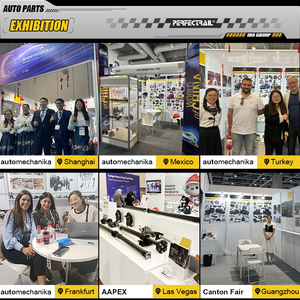(117133 products available)


































































































































































































Engine Components:
The engine is the fundamental aspect of a vehicle as it produces power. As a result, it has many parts that work together to ensure smooth operation. Some of the vital engine components are the cylinder head, air intake manifold, exhaust valves, and timing chain.
Drivetrain Components:
The drivetrain is another critical component of a vehicle. It is in charge of moving power from the engine to the wheels so they can spin. Some key components of the drivetrain include the axle shafts, driveshaft, differential, and wheel bearings.
Body and Chassis Parts:
Some fundamental components of a vehicle's body and chassis are bolts, chassis wiring harnesses, body panels, and bumpers. A vehicle's body and chassis offer support and help maintain its structure.
Electrical and Lighting Parts:
Every vehicle has crucial electrical components that ensure it runs smoothly. Be it the battery, alternator, or wiring. These components are responsible for storing and distributing electric power all over the vehicle. Also, lighting parts like headlight bulbs offer illumination to drivers at night or in low-visibility situations.
Interior Components:
A vehicle's interior space has several components, such as seats, trim, the center console, and door panels. These interior components enhance comfort and give a vehicle its distinctive look.
Suspension and Steering Parts:
Vehicles have several suspension and steering components that help with stability and control. Some of the vital steering parts are the power steering pump, linkage, and rack. On the other hand, the suspension has components like struts, suspension bushings, and shock absorbers.
Brake Parts:
There are two major brake parts in a vehicle. They are the brakes and the brake pads. The latter is responsible for slowing down the wheels and bringing the vehicle to a halt. Other brake components include brake calipers, brake lines, and brake cylinders, which ensure smooth and safe stopping power.
Accessories and Trim:
Some Ford OEM parts are not critical for a vehicle's operation. Instead, they enhance its functionality and appearance. They include accessories like roof racks, towing packages, and custom trims.
Specification of OEM parts varies depending on the manufacturer and the part in question. However, all specifications have one thing in common; they are meant to ensure safety, reliability, and quality.
Compatibility
Compatibility refers to the ability of a component to work effectively with another without interference. For instance, the car battery must be compatible with the electrical system to power all the components effectively.
Quality
Quality is a specification that is important to many users. People want to use parts that are of great quality. Quality is important because it ensures reliability and durability. For instance, when a mechanic uses a high-quality spark plug, it will last for many years. The plug will also spark consistently, ensuring the car runs smoothly.
Warranty
Warranty is a specification that provides assurance to users. The warranty gives the user peace of mind, knowing that if anything goes wrong, they is covered. A good example is a car tire warranty. If the tire fails prematurely, the manufacturer can replace it free of charge.
Performance
Performance is a specification that is highly sought after, especially in critical components like the engine. Users want parts that will give them excellent performance. For instance, a performance air filter can improve engine efficiency by increasing airflow.
Safety
Safety is a key consideration in all vehicle parts and accessories. Components like brake pads and safety glass have safety as their number one priority. The brake pads must meet specific standards to ensure they stop the car effectively, even under extreme conditions.
Certification
Certification is an important specification for vehicle parts. It ensures that the components meet set standards. For instance, a certified car seat has gone through many tests to ensure it can protect a child in case of an accident.
Maintaining OEM parts is not that hard. Like other parts of a vehicle, they require maintenance to last longer. Here are a few tips on how to maintain the parts:
Selecting the right Ford OEM part for a vehicle isn't a one-off activity. It requires careful consideration of several factors. Here's a guide to help make the selection process easier:
It is important to note that not all OEM parts are suitable for DIY replacement. Some components, such as engines, require a certified technician to handle them. That said, here is a general guide on how to replace a ford OEM part:
Q1: What is a Ford OEM part?
A1: A Ford OEM part is a genuine component made by Ford to match the original parts used in their vehicles. These parts guarantee a perfect fit and reliability, just like the initial components in the car.
Q2: Why should one choose Ford OEM parts for their vehicle?
A2: Selecting Ford OEM components ensures that the car's parts are precisely fitting and working, just like the originals. This keeps the vehicle running smoothly and dependably. Plus, it helps maintain the warranty's value and the car's resale price.
Q3: Are Ford OEM parts different from aftermarket parts?
A3: Yes, there's a significant difference. While Ford OEM parts are authentic and match the original components perfectly, aftermarket parts aren't made by Ford. They could vary in quality or fit compared to the real OEM parts.
Q4: Is it safe to use aftermarket parts in a Ford vehicle?
A4: While some aftermarket brands could be decent, they might not match the quality of Ford's OEM parts. Using them could risk a poor fit or performance, potentially causing car issues. It's best to stick with Ford's OEM parts for safety and reliability.
Q5: What should one do if they cannot find a specific Ford OEM part?
A5: If finding a particular OEM part is challenging, contacting a local Ford dealer or exploring Ford's official online channels is good. They can assist in sourcing the desired component.